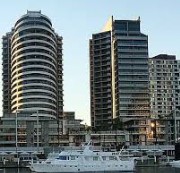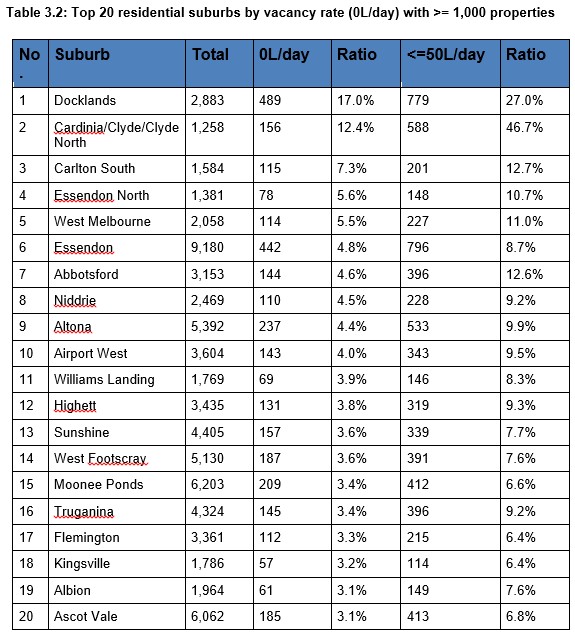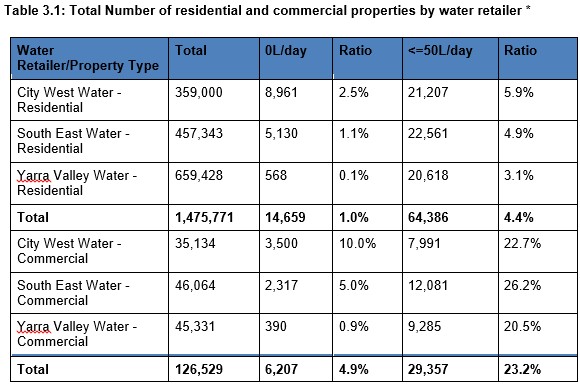
The report is unique because it uses water use data from Melbourne’s three main metropolitan water retailers to determine whether a home is being used, with very low recordings of water consumption data used as a proxy to determine vacant dwellings.
Speculative Vacancies (SVs) are measured as properties with abnormally low water usage. That is, any residential landholding using less than 50 litres per day (LpD), averaged over a 12 month period is deemed a speculative vacancy. In many cases, these are likely held for speculative gain by property investors.
Because these properties are not for rent, they are overlooked by current short-term vacancy measures reported by real estate firms.
Analysis was undertaken of 94.4% of 1,475,771 residential properties in 393 suburbs over the calendar year of 2013. Data indicates 64,386, or 4.4 per cent of Melbourne’s housing stock is potentially vacant and unused.
An examination of 126,529 non-residential properties in 399 suburbs over the same period identifies 29,357 or 23.2 per cent of Melbourne’s commercial stock is also potentially vacant and unused.
The breakdown by suburb shows that Docklands in Melbourne’s CBD has the largest proportion of vacant homes, with a whopping 17% of apartments (489 out of 2,883) consuming zero water over the the 2013 calendar year, and 27% using less than the 50LpD threshold. The prime inner city areas of Carlton South, Flemington, West Melbourne, and Abbotsford also have large stocks of vacant homes (see below table).

The report is particularly blunt in its assessment of Docklands:
[The Docklands] area is one of Australia’s biggest urban renewal projects, housing 5,789 residents (as at 2013) – 6 per cent of the City of Melbourne’s population.
Over 60 per cent of Docklands’ resident’s rent, indicating a large cohort of investor ownership. Thirty per cent of occupants are single person households, while a lack of essential education facilities and a peak in the demographic statistics between the ages of 0-4 indicates many families are forced out as their children approach school age…
The boom in apartment construction in Melbourne city has been done under the premises of improving affordability. However, the median rent a tenant can expect to pay to live in a one-bedroom Docklands’ apartment, is $432 per week, or a two-bedroom apartment, $530 per week.
A blunt measure of housing affordability stipulates a maximum of 30 per cent of income being spent on housing. For a tenant in the Docklands, this would necessitate an after-tax income of over $70,000 just to rent a one bedroom flat – a statistic severely exacerbated by the latent withheld supply…
A better measure of housing affordability is the NATSEM (National Centre for Social and Economic Modelling) barometer of housing stress, which measures people in the lowest 40 per cent of equivalised incomes (income adjusted using equivalence factors to remove the effect of household size and composition) across Australia, who are paying more than 30 per cent of their usual gross weekly income on rent or mortgage repayments.
In this respect, the decline of dwellings for low-income residents across Docklands and the municipality between the census periods of 2001 to 2011 is evident.
In 2001 low rent dwellings suitable for the lowest 40 per cent of incomes in the municipality accounted for 39 per cent of total rental dwellings; by 2011 that proportion had fallen to just 13 per cent – leading to a natural increase in the number of residents crowded into accommodation beyond their means.
The median purchase price for a one-bedroom apartment in this region is $410,000 and for a 2-bedroom apartment $595,000. Considering the units are internally between 60 – 80 square metres in size, when measured by rent or price on a per square metre basis, they are remarkably expensive…
The Docklands has been widely criticised as a planning disaster, lacking soul and the social facilities needed to cater to resident’s needs. However, the bigger disaster is that tracts of valuable urban land are being used for a large proportion of dwellings that are sitting long-term empty and unused – seemingly not for sale, or rent.
The report also explains four key factors inflating apartment costs, which precludes affordable homes from being built:
• Zoning Laws – Melbourne’s new zoning regulations render a larger percentage of primary neighbourhoods immune from dense development, whilst others have been given the green light. This naturally limits the tight concentration of land where high-density construction can occur and from a micro perspective, escalates the already inflated values in the areas deemed suitable.
• Construction costs – Development levies and infrastructure contributions are a prerequisite to construction and naturally passed to the buyer in the form of higher prices. Additionally, the physical impediments of building residential towers raises efficiency costs relative to low rise considerably, with increased floor areas required for structural supports, elevators, service ducts and so forth. Albeit, even if building costs were to reduce, there is no guarantee the savings would be passed onto the buyer. Rather, current tax legislation ensures the extra funds would be soaked up in higher land values.
• Supply elasticity – Most developers currently gain funding offshore , however, financing can require up to 100 per cent debt coverage with projects taking a number of years from concept to ‘lock up’ before supply can filter onto the market – a 3-6 year window not being unusual.
• Inflated Commissions and Rental Guarantees – Buyers typically purchase the stock through financial intermediaries who receive inflated commissions to achieve necessary presale targets. Meanwhile, investors are commonly ‘lured in’ with rental guarantees that promise a return that exceeds current market yields.
To build a 3-bedroom apartment suited to Melbourne’s biggest demographic – families with children – would therefore not be feasible under a purchase price of at least $700,000.
However, the standard of accommodation is typically low grade. It is not uncommon to find bedrooms and bathrooms lacking external windows and requiring artificial lighting at all hours.
As well as how supply policies on the fringes of the city are politically manufactured to keep prices elevated:
• Precinct Structure Plans – Although an area may be zoned for residential development, building cannot commence until a precinct structure plan (PSP) has been completed.
• Supply Elasticity – The PSP takes a lengthy 3 to 4 years from start to completion – during which time, speculation builds and land prices naturally increase.
• Withheld land within PSPs – Once the process has been finalised however, it does not guarantee housing will be constructed. It is not uncommon for up to 50 per cent of a completed PSP to be held by existing landowners who have no intention of building, and unless they do – are excluded from making contributions toward infrastructure financing. This leaves active buyers paying the passed on premium without receiving the associated amenities for a number of years.
• Development Levies – Total development levies and taxes on a house and land package are currently borne by the homebuyer, accounting for upwards of 40 per cent of the final sale price.
• Staged Releases – When land is developed, plots are ‘staged’ in limited numbers to ensure a return on profit. This drip feeding is ignored as price manipulation. Additionally, land sizes (not land prices) have been cut to maximise yield.
This combination of factors results in a process of false scarcity, where land values per square metre continue to rise despite an increase in the stock of dwellings.
The motivation behind the process is clear and the system is self-feeding. Property is valued against recent sales with land used as collateral to extend additional debt to new homebuyers who are left shouldering the speculative premium.
Finally, the report recommends fundamental reform of the housing/taxation system to free-up supply and reduce incentives to speculate:
The decline in housing affordability for first-time buyers has been exacerbated by impediments to the release of land for housing. Our current system of taxation compounds the problem by rewarding ‘property barons’ while tax inefficiencies such as developer charges are passed onto the buyer in the form of higher land and housing costs.
This report recommends fundamental reforms which are required to reduce the propensity toward volatile boom and bust land cycles. These are fuelled by speculation and unsustainable levels of household debt.
We submit that these causes would be alleviated or removed if current transaction taxes were replaced with a holding tax levied on the unimproved value of land. The report further advocates how the funds can be raised to aid infrastructure development as well as incentivising housing supply. The housing market must respond in a timely manner to homebuyer rather than speculator demand.
The Speculative Vacancies report will be publicly released on the Prosper website later today. It is well worth reading.


